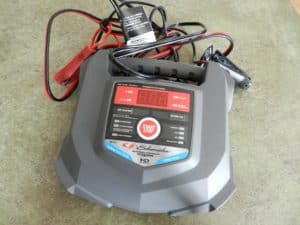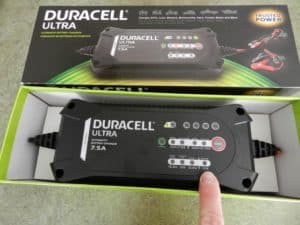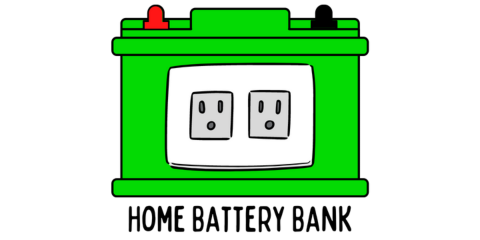Once you get over the stress of buying the correct 12-volt battery for your needs, you will quickly find that you might encounter even more stress when it comes to picking the best 12-volt smart charger and maintainer as well.
Initially, buying the right battery seemed like the hardest part. I was completely wrong. I have been through the ringer when it comes to getting a proper charger. I didn’t realize how draining (no pun intended) finding a functioning, consistent, safe, and reliable device would be.
If you’re not careful, simply buying a charger, hooking it up and walking away can mean murder for your batteries and cause a serious safety hazard to your house and everyone in it.
Ideally, when selecting a charger for your battery bank, it is a good rule of thumb to follow the 10% Rule. That is, you will seek a smart charger who’s amp rating is 10% of the total amp hours of your entire battery backup system. If you have a 100AH marine battery, you will look for a 10 amp charger.
There are some caveats to this rule, and concerns to be aware of, but it serves as a baseline.
This article will cover my experiences when buying a smart charger for a small DIY battery bank, but it is applicable to any 12-volt application. In my case, I have two GC2 (6-volt golf cart) batteries hooked in series for a 12-volt system and 215 amp hours.
I’m going to touch on my experiences with buying and using different brands of chargers and hopefully save you some trouble. I’ll cover what chargers I’m currently using, which ones I would avoid, and the end of the article will contain useful lessons I’ve learned to help you no matter what battery or charger you decide to go with.
Let’s get started!
My Story
When I got over the stress of buying my first batteries (two GC2 Golf Cart Batteries) I loaded them into the car and headed over to Walmart to buy a charger that I had seen. It was a charger that “automatically selects charge rate for charging and maintaining” and was “microprocessor controlled.” I felt very confident in my battery research but I fully admit that I hardly did any work when researching the charger that I should buy.
Seriously though, how hard could the selection process for a battery charger and maintainer be? With all of them out there, they should have the kinks worked out of them by now, right?
WRONG!
I soon found myself immersed in a frustrating land of possibly-dysfunctional devices, false advertising, and manuals that failed to answer even the simplest questions about the products they came with. It seemed the chargers I would purchase over the next month would all attempt to murder or sabotage the two beautiful 60 lb babies I had bought to give me power during a storm.
My first 3 Battery Chargers – All Schumacher brand (Losers!)
Just know that before I continue it is not my intent to bash a particular company. However, when a certain feature of your product can cause a potentially dangerous environment for everyone around, I am going to mention it.

Sitting so prominently on the Walmart shelves were various chargers sporting different Amps all from a brand called Schumacher. I felt great about what I was about to do. I had about $90 saved and I realized I could buy a single charger for that money and it would be a 30 amp charger, or I could buy two 15amp chargers.
Even though I like redundancies in my life, I bought the 30 amp charger first. When I got home and hooked it up to my battery bank (which already had a volt reading of 12.7+, so, fully charged) I watched the volt reading climb quickly to over 16.4 volts and stay in that range.
The bubbling was intense and sounded like my battery was boiling from 20 feet away! The house really started to stink and I knew that hydrogen and hydrogen sulfide were being released. Multiple resets of the procedure resulted in the same outcome.
I returned the unit to Walmart and bought the two 15 amp chargers just to have one as a backup in case a charger failed during a power outage or other inconvenient time. When I got home I hooked everything up to my battery bank as safely and as according to the instructions as possible.
My first indication that something was wrong was that the display gave me a very low number for the percentage of battery life. These were brand new batteries and my voltmeter clearly showed that they were reading 12.7 volts (without being hooked up to a charger) which was at or near fully charged.
I assumed that maybe I’m just crazy and these chargers were just running diagnostics and would correct itself shortly. Instead, it took the voltage on the voltmeter quickly from 13.7 to 16.4 and kept creeping up within a matter of minutes. The boiling sound and the smell got the best of me again. The other charger did the same thing. I immediately unplugged and did some research.
Desulfation
What I came to learn is that even though Schumacher doesn’t advertise it on the box, they gave a tiny two sentence paragraph within their manual that the unit will perform a desulfation process on the batteries.
“Desulfation could take 8 to 10 hours. If desulfation fails, charging will abort and the BAD BATTERY (red) LED will light.”
That’s it, and that’s all.
Quick explanation: The desulfation process basically runs a high current in the battery to break up the crystals that start to form on the lead plates due to improper charging or letting a battery sit idle when not fully charged.
This paragraph said the process could take up to 8-10 hours and that’s it. It did not mention how high the voltage would read. It didn’t mention any precautions to take. It didn’t mention whether this is the first step of the charging process each and every time you hook it up to a battery or if it would automatically start a desulfation process a month later while already in “maintain mode.”
No information could be found on their website and I couldn’t find any proper answers online, except that it seems 50% of the people say that Schumacher chargers boil and kill batteries, and the other 50% seem to think Schumacher chargers perform as expected. Risking $200+ worth of batteries on a coin toss?!
When I reached out to Schumacher asking them if this model charger would desulfate automatically upon hook-up, I received the following:
Good Afternoon
If the charger is kept on the battery for a lengthy period of time then yes, the charger will do the desulfation as needed.
Thank You
Customer Service
Schumacher Electric Corp.
My experience is that it will desulfate immediately upon hooking up, and I’m guessing it will be a monthly occurrence.
Schumacher Battery Charger Conclusion
I’m not saying that their products are defective. I will say though, that I will not be using them indoors. I do not trust them based on the lack of information that they have provided with their product. Also, the fact that the desulfation mode wasn’t advertised on the box got under my skin a bit.
The last thing I need is a charger that practically boils a battery at random when I am sleeping or away from home. I’d be lucky to have just some irritation to my nasal passages and throat when an exploding house or melted battery could be a possibility.
If it is going to desulfate, that’s fine. I just would like to know what to expect from their product and I will have to bring the batteries to the garage and keep the doors open when doing it. They will also have to be monitored the entire time – and I have better things to do than to babysit a battery intently for 8-10 hours.
Another downside is that this charger won’t be able to be used indoors since when I bring it back in and hook it up it will start the desulfation process all over again even though I just spent 8-10 hours completing it in the garage already!
To be fair, no battery charger manufacturer recommends charging a battery in your house.
Charger #4 – Duracell (Winner!)
Now that I had removed Schumacher chargers from the equation, I went back to the place where I bought my batteries. I picked out a rather expensive charger with half the amps of my previous Schumacher charger.
I chose the Duracell® Ultra 7.5 amp (SLC10005). This is a bit under the recommended amp rating for a charger since my battery bank is 215 amp hours (typically 10% of the total amp hours is the amp rating for a charger – so 20 to 30 amps would have been an ideal charger).

Regardless, it worked well and charged like it should. It also has a button where you can choose to go into the “recover” mode which will take care of the desulfation. I appreciated this as an option and not having it forced on me.
The only weird thing about this when compared to the final charger below, is that when it is in float/maintenance mode, the voltage bounces around between 12.7 and 13.3. Maybe it starts at 13.3, stops the float charge, and then when it gets down to 12.7 it brings it back up? I don’t have the time to monitor the battery dropping 0.01 volts per hour to find out.
Charger #5 – Battery Tender® (Winner!)
I bought the 4 amp Battery Tender® charger and maintainer at a bit of a cost as well. I haven’t been disappointed by this one though; I just wish it had a higher amp rating. It goes through its cycles and when it tells me it hits 100% it goes into float mode and I can monitor that on my voltmeter as it hovers between 13.15 and 13.17.

Overall, I have been very pleased with the Battery Tender® and it has given me no reason not to trust it. I highly recommend them!
This is the charger (seen on Amazon) that I leave hooked up to my battery bank at all times and gives a perfectly gentle charge to my battery which is what I am looking for — especially since I have my battery bank indoors. (The manufacturer does not advocate for using their product indoors. Do so at your own risk.)
Lessons Learned with Charging:
- Three-stage, Smart Charger, or Microprocessor Controlled are probably the best options if you’re new to batteries. If you go with a manual charger, you’re going to have to learn to program it and not overcharge your battery.
- The chargers mentioned in the previous bullet point charge your battery in 3 phases: Bulk Charging (0%-80%), Absorption Mode (80%-100%)and Float Maintenance/Storage Mode (keeps it 100%-103%).
- Battery chargers should ideally have an amp rating that is about 10% of your battery backup system’s total amp hours. Example: a 100AH marine battery should have a 10 amp charger; a 200AH system should have a 20 amp charger.
- To calculate the speed of a charge, just know that the amp rating of the charger is the number of amp-hours that will be replaced in your battery bank per hour. For example, a 10 amp charger will replace 10 amp-hours per hour and would take a little over 10 hours to charge a 100AH battery from full discharge.
- “Float charging” and “Trickle charging” are not the same thing.
- Trickle charging keeps a low but predetermined set current flowing to the battery after it is fully charged, and ruins the battery over time by constantly pumping current into it.
- Float charging senses exactly what a battery needs as it naturally self-discharges and it supplies that amount.
- Buying a charger that has too high of an amp rating for your system can damage it by overheating it. Buying a charger that is too low of an amp rating might not be able to charge your batteries if you let them go below a certain depth of discharge. Again, try to keep the 10% rule in mind.
- Read your manuals when you get your charger! Make sure if it claims it maintains batteries that it truly is a battery maintainer. Check to see if it has an automatic “desulfation mode”. If it does, you’ll want to think twice about using it indoors.
- Hydrogen and oxygen are released during normal charging but especially during desulfation mode. Hydrogen sulfide, which smells like rotten eggs and is harmful to breathe in, is also released during overcharging — like in the controlled desulfation mode.
- Just know that hydrogen atoms are 16 times less dense than air and they are trying like hell to get out of your house as fast as possible. They do not linger around and congregate like the smell you make when you eat too many bean burritos.
- Hydrogen seeks to rise up through the air at 45 miles per hour. That is faster than you can run. That is faster than Usain Bolt can run. Unless it is confined in a small, airtight room with no means to escape, I’m not too worried about it with the size of the set-up that I have.
- Batteryuniversity.com has a great page on health safety with regards to batteries at this link. It’s easy to understand and is definitely worth a quick read!
- Personally, under normal conditions (excluding desulfation mode), I am only worried about the potential hydrogen build-up underneath the caps of my batteries and that’s why a spark can be dangerous.
- To avoid sparks, unplug and/or plug-in your charger AFTER the clamps are already attached to your battery terminals!
- Remember this phrase to avoid sparks above the battery when hooking up your charger: Hook up before you plug in. Unplug before you unhook.
- A fan blowing on the battery can also dissipate any concentrated hydrogen build-up when you’re doing maintenance work on your battery.
- To avoid sparks, unplug and/or plug-in your charger AFTER the clamps are already attached to your battery terminals!
- If you’re really worried about leaving a charger connected to the battery at all times, you can just give it a charge once or twice a month to bring it back up to 100%. It shouldn’t take more than 10 minutes, and then you can just keep them unplugged in the meantime. Healthy batteries will self-discharge at a very slow rate.
- I currently unplug my charger when leaving for the weekend or vacation but I am considering it for the majority of the time and just plugging it in once a week or so to keep it topped off.

Final Thoughts
Having a battery backup system is supposed to bring you a sense of peace and assurance in this life when it comes to providing for your family. The learning curve and purchases can be anything but peaceful and assuring! Ultimately, make common-sense decisions, do your research, and I hope that my experiences can help you to make some smart decisions for you and your family!
